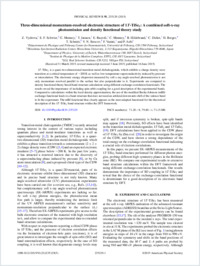Three-dimensional momentum-resolved electronic structure of $1T\text{-}{\mathrm{TiSe}}_{2}:$ A combined soft-x-ray photoemission and density functional theory study
- Vydrova, Z. Département de Physique and Fribourg Center for Nanomaterials, Université de Fribourg, Switzerland
- Schwier, Eike Fabian Hiroshima Synchrotron Radiation Center, Hiroschima University, Japan
- Monney, Gaël Département de Physique and Fribourg Center for Nanomaterials, Université de Fribourg, Switzerland
- Jaouen, Thomas Département de Physique and Fribourg Center for Nanomaterials, Université de Fribourg, Switzerland
- Razzoli, Elia Département de Physique and Fribourg Center for Nanomaterials, Université de Fribourg, Switzerland
- Monney, Claude Department of Physics, University of Zurich, Switzerland
- Hildebrand, Baptiste Département de Physique and Fribourg Center for Nanomaterials, Université de Fribourg, Switzerland
- Didiot, Clément Département de Physique and Fribourg Center for Nanomaterials, Université de Fribourg, Switzerland
- Berger, Helmuth Institut de Physique de la Matière Complexe, EPF, Lausanne, Switzerland
- Schmitt, T. SLS, Paul Scherrer Institute, Villigen PSI, Switzerland
- Strocov, V. N. SLS, Paul Scherrer Institute, Villigen PSI, Switzerland
- Vanini, Fabiano Département de Physique and Fribourg Center for Nanomaterials, Université de Fribourg, Switzerland
- Aebi, Philipp Département de Physique and Fribourg Center for Nanomaterials, Université de Fribourg, Switzerland
-
16.06.2015
Published in:
- Physical Review B. - 2015, vol. 91, no. 23, p. 235129
English
1T−TiSe2 is a quasi-two-dimensional transition metal dichalcogenide, which exhibits a charge density wave transition at a critical temperature of ∼200 K as well as low- temperature superconductivity induced by pressure or intercalation. The electronic energy dispersion measured by soft x-ray angle-resolved photoemission is not only momentum resolved parallel to the surface but also perpendicular to it. Experiments are compared to density functional theory based band structure calculations using different exchange-correlation functionals. The results reveal the importance of including spin-orbit coupling for a good description of the experimental bands. Compared to calculations within the local density approximation, the use of the modified Becke-Johnson (mBJ) exchange functional leads to a band structure that does not need an artificial downwards shift of the valence band to fit the experiment. The mBJ functional thus clearly appears as the most adapted functional for the theoretical description of the 1T−TiSe2 band structure within the DFT framework.
- Faculty
- Faculté des sciences et de médecine
- Department
- Département de Physique
- Language
-
- English
- Classification
- Physics
- License
-
License undefined
- Identifiers
-
- RERO DOC 257310
- DOI 10.1103/PhysRevB.91.235129
- Persistent URL
- https://folia.unifr.ch/unifr/documents/304592
Statistics
Document views: 137
File downloads:
- pdf: 159
